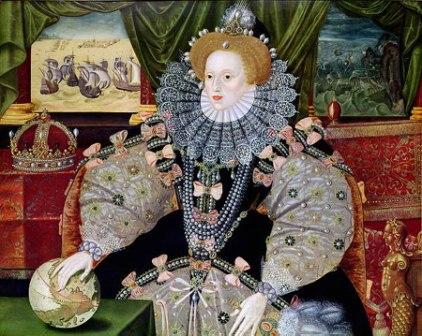 |
| A portrait of Robert Devereux, the Earl of Essex, painted between 1590-96 by Marcus Gheeraerts. Picture acquired through Wikimedia Commons. Image public domain. |
No amount of planning could prepare Essex for an Irish uprising that was so large and so damaging to the English that it was unprecedented in recent history. None the less, Essex probably could have suppressed the rebellion had he done what he had been expected to do: take his army straight to Ulster to confront the Earl of Tyrone. But instead, Essex chose to blaze his own trail, taking his men through Munster where they were ambushed by the Irish. Essex disregarded the fact that he was not a free agent and that he was sent on his mission because Queen Elizabeth had good faith in him; He made an impulsive decision that he was not authorized to make without prior approval of the crown, calling a truce with the Irish.
Elizabeth had been kept up to date on Essex's escapades in Ireland, and she was outraged at every twist and turn in the story. Essex and Tyrone actually forged some sort of a friendship, and when Essex abandoned his army and returned to court without the queen officially recalling him to her side, (a grave offence) he had the audacity to petition his benefactress on the Earl of Tyrone's behalf! This was the final straw for Elizabeth, who reprimanded him severely and had him forced into exile in within the boundaries of her realm. She did not want to look at him, nor did she want him to enjoy himself, gallivanting about with his friends.
 |
| Another portrait of Robert Devereux, the 2nd Earl of Essex. Picture acquired though Wikimedia Commons. Image public domain. |
During Queen Elizabeth and Essex's separation, more intelligence began to get back to the queen on her favorite's misdeeds. It was clear to her that she could no longer protect and defend the Earl, and he was put on trial in June of 1600. Essex was tried by his peers, and while he was not at this time convicted of any serious crime, he was dismissed of his offices and sentenced to be held under house arrest. This was an unfathomable punishment for a man who relished the spotlight, and Essex began scheming almost immediately to change his fortunes. While Essex was lucky enough to be released from his gilded cage just two months later, he tried to push his luck by attempting to win back the queen, but she refused to associate with him any more. Essex became increasingly paranoid and aggressive, and somehow he deluded himself into believing that Robert Cecil, whom he had long hated, and certain members of the previous council were poisoning Queen Elizabeth's mind against him. Essex concocted a plan to use military force against the government to remove these parties that he deemed offensive.
 |
| The Kitchner Portrait of Elizabeth I, 1580. Picture acquired through Wikimedia Commons. Image public domain. |
Contemporaries outside of Essex's circle of sycophants and modern scholars can agree that Essex's allegations had no bearing; these were the rants of a madman nursing his wounded pride. And as I have explained in previous articles, everyone who knew Queen Elizabeth, especially those members of her inner circle, knew that no one persuaded to the queen to do anything against her own will. Queen Elizabeth was a pragmatist and a master politician, who heard endless points of view and deliberated for months, sometimes years before ever making a decision. No man could influence her without her permitting it.
 |
| The Hardwick Portrait of Elizabeth I, 1592. |
Essex must have learned nothing from the Duke of Norfolk when he conspired with the Scots to enact a coup d'etat. Essex contacted King James VI and his friend Lord Mountjoy in the hopes that they would support his uprising.
The Scottish king wisely declined, so Essex's only real comrades were his cronies, who did not have the military power or political leverage to contribute anything critical to his cause, with the exception of his friend (and Shakespeare patron) Henry Wriothesley, the Earl of Southampton. Essex and Southampton and a few supporters stormed London unsuccessfully-even the street people of London knew Essex's crusade against the queen was ill-advised. The rebels were captured and sent to the Tower.
Essex was tried for treason. Some of his former associates, like the Lord High Admiral Charles Howard, with whom he had attacked the Spanish base at Cadiz, passed judgement on him. Queen Elizabeth had suffered the ultimate betrayal at the hands of Essex-the betrayal of a friend. She did not deliberate for long, before she signed his death warrant.
 |
| A detail from a portrait of Lord High Admiral Charles Howard. Picture acquired through Wikimedia Commons. Image public domain. |
Robert Devereux, son of Walter Devereux and the queen's cousin, Lettice Knollys, was beheaded in 1601. Southampton would survive in the Tower long enough to see the light of day again when King James VI of Scotland became James I of England as Elizabeth's successor. The Earl of Essex's son with his wife, Frances Walsingham, was disinherited, but his rights were later restored by James I; He became the 3rd Earl of Essex.
The Earl of Essex truly embodied the notion "pride cometh before a fall", and although he was the queen's last great favorite, they were not intimates as she and his stepfather Robert Dudley, the Earl of Leicester had been. Theirs was a connection of folly and flirtation, not long talks and shared minds. Sadly, Essex's only legacy is his betrayal of England's most beloved queen.














